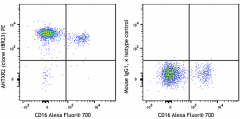- Clone
- H8R23 (See other available formats)
- Regulatory Status
- RUO
- Other Names
- Capillary morphogenesis gene 2 (CMG2)
- Isotype
- Mouse IgG1, κ
- Ave. Rating
- Submit a Review
- Product Citations
- publications

-

Human peripheral monocytes were stained with anti-human CD16 Alexa Fluor® 700 and anti-human ANTXR2 (clone H8R23) PE (left) or mouse IgG1, κ PE isotype control (right). Dot plots are gated on monocyte population in human lysed whole blood.
| Cat # | Size | Price | Quantity Check Availability | Save | ||
|---|---|---|---|---|---|---|
| 318403 | 25 tests | £122 | ||||
| 318404 | 100 tests | £271 | ||||
ANTXR2 is a type I transmembrane protein, with an extracellular van Willebrand factor A (vWA) domain, an Ig-like domain, a single transmembrane helix and a cytoplasmic tail. It binds to the toxins of Bacillus anthracis, such as protective antigen (PA), in a divalent cation-dependent manner. Upon binding of the protective antigen (PA), the complex moves to glycosphingolipid-rich lipid rafts and internalized. In the endosomal membrane, the toxin-receptor complex forms a pore, which allows the other components of anthrax toxin to escape to the cytoplasm. It also binds to laminin, and possibly collagen type IV, which may indicate that this receptor involves in the formation of capillaries and maintenance the structure of basement membranes.
Product DetailsProduct Details
- Verified Reactivity
- Human
- Antibody Type
- Monoclonal
- Host Species
- Mouse
- Immunogen
- HCC827 GR2 cell line
- Formulation
- Phosphate-buffered solution, pH 7.2, containing 0.09% sodium azide and BSA (origin USA)
- Preparation
- The antibody was purified by affinity chromatography and conjugated with PE under optimal conditions.
- Concentration
- Lot-specific (to obtain lot-specific concentration and expiration, please enter the lot number in our Certificate of Analysis online tool.)
- Storage & Handling
- The antibody solution should be stored undiluted between 2°C and 8°C, and protected from prolonged exposure to light. Do not freeze.
- Application
-
FC - Quality tested
- Recommended Usage
-
Each lot of this antibody is quality control tested by immunofluorescent staining with flow cytometric analysis. For flow cytometric staining, the suggested use of this reagent is 5 µL per million cells in 100 µL staining volume or 5 µL per 100 µL of whole blood. It is recommended that the reagent be titrated for optimal performance for each application.
- Excitation Laser
-
Blue Laser (488 nm)
Green Laser (532 nm)/Yellow-Green Laser (561 nm)
- RRID
-
AB_2876622 (BioLegend Cat. No. 318403)
AB_2876622 (BioLegend Cat. No. 318404)
Antigen Details
- Structure
- Type I transmembrane protein, with an extracellular van Willebrand factor A (vWA) domain, an Ig-like domain, a single transmembrane helix and a cytoplasmic tail. 54kD.
- Distribution
-
ANTXR2 is expressed on T cell, B cell, dendritic cell, monocytes, and granulocytes.
- Function
- The ANTXR2 protein acts as a receptor for the toxin that causes anthrax, allowing the toxin to attach to cells and trigger disease. The ANTXR2 protein is also involved in the formation of capillaries and maintaining the structure of basement membranes.
- Ligand/Receptor
- Protective antigen (PA), laminin, collagen type IV
- Cell Type
- B cells, Dendritic cells, Granulocytes, Monocytes, T cells
- Biology Area
- Bacterial proteins and Toxins
- Molecular Family
- Adhesion Molecules
- Antigen References
-
- Burgi J, et al. 2017. Nature Comms. 8:15861
- Scobie H, et al. 2003. Proc. Natl. Acad. Sci. USA. 100:5170
- Gene ID
- 118429 View all products for this Gene ID
- UniProt
- View information about ANTXR2 on UniProt.org
Related Pages & Pathways
Pages
Related FAQs
- What type of PE do you use in your conjugates?
- We use R-PE in our conjugates.
Other Formats
View All Reagents Request Custom Conjugation| Description | Clone | Applications |
|---|---|---|
| PE anti-human ANTXR2 | H8R23 | FC |
| Purified anti-human ANTXR2 | H8R23 | FC |
Compare Data Across All Formats
This data display is provided for general comparisons between formats.
Your actual data may vary due to variations in samples, target cells, instruments and their settings, staining conditions, and other factors.
If you need assistance with selecting the best format contact our expert technical support team.
-
PE anti-human ANTXR2

Human peripheral monocytes were stained with anti-human CD16... -
Purified anti-human ANTXR2

Human peripheral blood monocytes were stained with anti-huma...
 Login / Register
Login / Register 












Follow Us